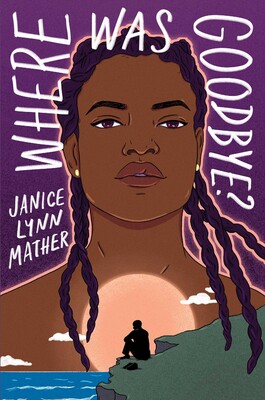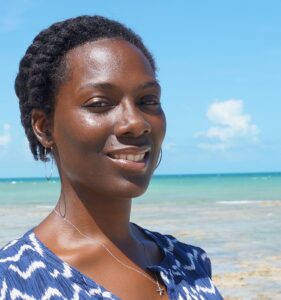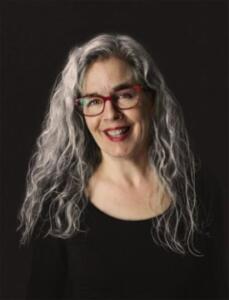Coping with a final goodbye
Where Was Goodbye?
by Janice Lynn Mather
Toronto: Simon & Schuster Canada, 2024
$23.99 / 9781665903950
Reviewed by Alison Acheson
*

“It feels weird to be joking. Weird but good. Like it’s okay for there to be a bit of extra air in the world.” —from Where Was Goodbye?
Where Was Goodbye?, the title of Janice Lynn Mather’s newest novel for young adults, captures the essence of the story, and sets up the theme and significance of ‘questions’ in this work. And does exactly what a good title should.
It’s tough to live with questions, to go through the day-to-day—and nights, too—with them. But this YA novel, the third by Tsawwassen’s Mather (after Facing the Sun and Learning to Breathe), evokes a time of life-with-too-many-questions. Questions with enough weight to drag down. The central character, Karmen, seems unable to gather satisfying answers as she bobs among the flotsam of a life ended too soon. Slowly, through the pages, she pulls together just enough bits and pieces. This story is realistic of grief and pain.
Mather places a caveat in the early pages of the work, before a reader enters the story. In honour of her choice, I will also let you know thatWhere Was Goodbye? is a story of a young woman—a high school senior—dealing with the recent death-by-suicide of her older brother.
The story opens with an autumnal back-to-school time frame, only six weeks after Julian—brother—has died. Altogether with the awkwardness of first day back, some understandable “acting out” on Karmen’s part, poor handling by adults, and bullying on the part of another student, she finds herself at home on an undefined length of leave-from-school. That confinement creates a realistic and necessary emotional and physical space.
For those who have actually experienced this type of grief, the story might be too much. But for others who want to know how to support those who’ve been through, or for those who want to understand something of human journeys—and how to mourn, how to live with grief—the story is a study in how we might navigate. Life isn’t simple; that’s the truth in the pages in the reader’s hands.
Karmen’s friend of many years, Layla, is hopeful and hovering to the end, and those of us who’ve been on the planet for a while will recognize Layla’s well-intended attempts to be the best friend she can be… even if it means parroting ineffectual words from five-step grief books. In my experience, even so-called adults often don’t know what to say in such times. Layla’s efforts endear her even as she irritates, too. This dance of friendship reveals the twists and turns toward and away—even as both young women feel their way through this growing up piece that’s been thrust on them.

Throughout, Mather returns to a sense of poking into darkened corners, taking on the fears of the unknown. Really, the main character and the reader are stepping off their own edges—dropping in on a board, if you want to go with the metaphor of skateboarding in these pages—trusting that somehow this thing called Life is going to take hold, and while it might not give answers, it can still keep its fingers tightly around you, safe. Because in the end there is a sense of it working out as well as can be, in the way that life does. As it must. Alongside the trigger warning/caveat there should be a message of reassurance that this life-ride comes with a solid seatbelt in place.
Julian had been pursuing journalism, and those old “5 Ws” were what he preached to his younger sister. She now asks those questions as she seeks understanding, and tries to come to terms with the fact that there is no such thing. Between the clouds are fleeting bits of clear sky. There is Hope. Having a therapist-mother and a father who appears to want life to be “normal” as soon as possible doesn’t smooth the bumps in the road. Having understanding teachers, and even a good counsellor—and they are and she is—does help, but still, one needs to keep looking up for those blue patches.
Karmen even goes through a time of “inhabiting” Julian. She adopts his skateboard, his clothing, relives his routine, his writing. At one point, she even takes on his name. Grief pushes us into strange places; living with soul-busting “whys” is hard business for any age. But for this brokenhearted teenager, not only is it hard, it’s outright dangerous. Karmen goes to the edge herself in this story. But she herself pulls back. Life itself pulls her back, an affirming moment.
In the closing pages, there aren’t the answers that Karmen has been hoping to find, but there is honesty, extended by friends and family, as those who knew Julian open up and share.
Each piece offered, however small, is a part of the healing. Karmen’s new friend, Pru, has a revelation of her own toward the end of the novel. Shrines need to be dealt with: an untouched shoe rack, and a calendar with unchanged pages.
While life is never the same after loss, and no, time does not heal—that is, life never returns to what it was—it does all shift into something else, and Karmen comes to know this. Each step is just that. A step. The end is not tied in a bow, but it is knotted meaningfully.
There are wonderful lighter bits throughout: a love-interest who genuinely cares. This story-line is particularly effective in its assurance. And the use of flashbacks and italics to poignant scenes between Karmen and Julian and their parents is also well done, evoking times that will sustain; these scenes leave the reader with the feeling that in spite of the pain, this family will go on.
“I feel a smile stretch over my face. I think about those stories about my brother, wrapped up in people still walking around here. Carrying around their own small versions of him, each keeping Julian alive.” —from Where Was Goodbye?
*

Alison Acheson is the author of almost a dozen books for all ages, with the most recent being a memoir of caregiving: Dance Me to the End: Ten Months and Ten Days with ALS (TouchWood, 2019). She writes a newsletter on Substack, The Unschool for Writers, and lives on the East Side of Vancouver. [Editor’s note: Alison Acheson has also reviewed books by Li Charmaine Anne, Linda Demeulemeester, Hanako Masutani, Julie Lawson, George M. Johnson, Janice Lynn Mather, Jacqueline Firkins, Barbara Nickel, and Caroline Adderson for BCR; and Dance Me to the End: Ten Months and Ten Days with ALS was reviewed by Lee Reid.]
*
The British Columbia Review
Interim Editors, 2023-25: Trevor Marc Hughes (non-fiction), Brett Josef Grubisic (fiction and poetry)
Publisher: Richard Mackie
Formerly The Ormsby Review, The British Columbia Review is an online book review and journal service for BC writers and readers. The Advisory Board now consists of Jean Barman, Wade Davis, Robin Fisher, Barry Gough, Hugh Johnston, Kathy Mezei, Patricia Roy, Maria Tippett, and Graeme Wynn. Provincial Government Patron (since September 2018): Creative BC. Honorary Patron: Yosef Wosk. Scholarly Patron: SFU Graduate Liberal Studies. The British Columbia Review was founded in 2016 by Richard Mackie and Alan Twigg.
“Only connect.” – E.M. Forster
2 comments on “Coping with a final goodbye”